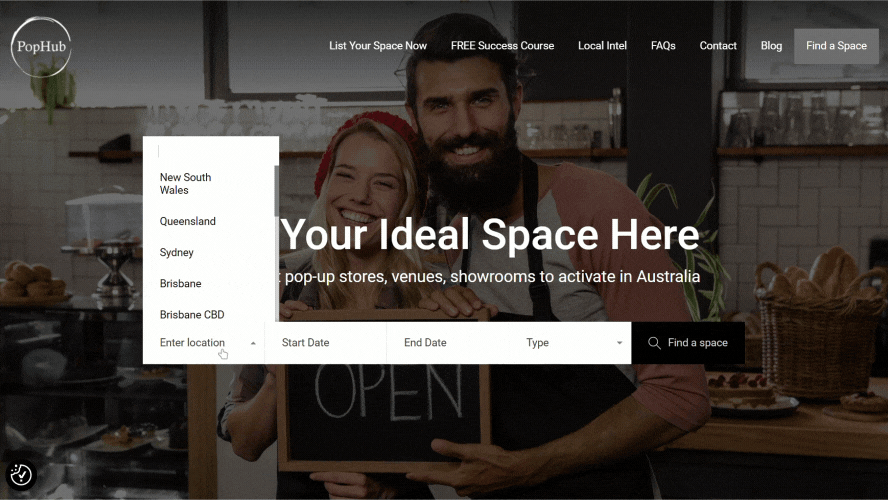
12 Small Business Strategies & Tips for 2025
Get expert-backed small business tips to improve your marketing, customer experience, and sales strategies—whether you run a pop-up or a permanent retail store.
Retail is evolving rapidly, and businesses must keep up with shifting consumer expectations. Traditional selling methods alone aren’t enough, and with more brands embracing pop-ups and flexible retail spaces, agility is essential.
Turning Challenges into Opportunities
Small businesses face growing concerns, with 48% citing economic uncertainty as a challenge and 45% anticipating difficulties in attracting new customers, according to research from LocaliQ.
However, consumer spending remains strong. A well-positioned retail space—whether permanent or temporary—can thrive with the right approach. If you’re launching or refining your retail strategy, these 12 actionable tips will help you succeed.
Strengthening Your Retail Foundation
1. Establish a Strong Brand Identity
Your brand identity shapes how customers perceive your business, so consistency is key. Develop a strong visual identity with clear messaging, appealing signage, and an inviting store atmosphere. A well-defined niche and unique selling point will help you stand out in a competitive market.
Create a strong visual identity with cohesive branding.
Define your niche and unique selling point.
Maintain brand consistency across all marketing channels.
2. Enhance Customer Convenience
Shoppers expect smooth and effortless transactions, making convenience essential. Offer multiple payment methods, including digital and contactless options, to cater to different preferences. Ensure a well-organized store layout with clear signage and accessible product details to improve the shopping experience.
Provide multiple payment options, including contactless methods.
Organize your store layout for easy navigation.
Display clear signage and product information.
3. Manage Costs While Staying Agile
Controlling expenses while remaining flexible is crucial for long-term success. Consider starting with pop-ups or shared retail spaces before committing to a full lease. Regularly track expenses and invest in high-ROI areas like marketing and inventory management to ensure profitability.
Test pop-ups or shared spaces before committing to long-term leases.
Track expenses and focus on high-ROI investments.
Adjust quickly to market trends to optimize sales and inventory.
4. Leverage Local Marketing
A strong local presence increases foot traffic and builds customer trust. Optimize your Google My Business listing and focus on local SEO to improve visibility. Collaborate with nearby businesses for cross-promotions, community events, and social media engagement to expand your reach.
Optimize Google My Business and improve local SEO.
Use social media and local ads to reach nearby shoppers.
Partner with other local businesses for mutual promotion.
5. Prioritize Customer Relationships
Building lasting relationships with customers fosters brand loyalty and repeat business. Engage with your community through in-store events and special promotions. Personalized communication, loyalty programs, and an active email list help keep your customers connected and coming back.
Host in-store events to engage your local audience.
Build an email list for promotions and business updates.
Offer rewards or loyalty programs to encourage repeat visits.
6. Address Customer Needs with Unique Solutions
Understanding and solving customer pain points help create a competitive advantage. Offer products or services that cater to specific needs, such as sustainable or locally sourced items. Regularly collect and analyze customer feedback to refine your offerings and enhance satisfaction.
Sell niche or sustainable products that match customer preferences.
Collect and act on customer feedback to improve offerings.
Focus on exceptional customer service to build trust.
Adapting to the Future of Retail
7. Streamline Operations with Automation
Efficiency allows you to focus on growth while reducing manual workload. Use digital tools to automate tasks like inventory tracking, appointment scheduling, and marketing campaigns. Delegating or automating repetitive work lets you spend more time improving your business strategy.
Implement digital tools for inventory and scheduling.
Automate marketing efforts like email and social media.
Delegate routine tasks to focus on business growth.
8. Create a Standout In-Store Experience
A well-designed store environment leaves a lasting impression and encourages repeat visits. Train staff to provide warm, personalized service that enhances customer satisfaction. Thoughtful merchandising, interactive displays, and inviting decor help create an engaging shopping experience.
Train staff to deliver excellent customer service.
Use interactive displays to make shopping engaging.
Enhance ambiance with lighting, music, and thoughtful design.
9. Select a High-Traffic Location
Choosing the right location significantly impacts foot traffic and sales. Look for spaces with steady pedestrian activity and easy accessibility. Ensure your store aligns with the local demographic and complements surrounding businesses to attract your target audience.
Prioritize high-foot-traffic locations with good visibility.
Ensure accessibility for customers, including parking options.
Research local demographics to match your ideal market.
10. Bridge Online and Offline Shopping
Offering an omnichannel experience keeps customers engaged across all platforms. Enable in-store pickup for online purchases and sync inventory across channels to avoid stock issues. Use QR codes to connect physical and digital shopping experiences seamlessly.
Provide in-store pickup for online purchases.
Keep inventory updated across all sales platforms.
Use QR codes for product details, discounts, or quick purchases.
11. Make Data-Driven Decisions
Tracking business performance helps refine strategies and increase efficiency. Monitor foot traffic, sales trends, and customer behaviors to adjust marketing and product selection. Data insights allow you to anticipate demand, avoid overstocking, and maximize profits.
Analyze foot traffic, sales trends, and customer habits.
Use data to optimize product selection and marketing strategies.
Forecast demand to prevent overstocking and lost sales.
12. Stay Innovative and Adapt to Trends
Remaining flexible and embracing change is essential for retail success. Stay updated on industry trends, new consumer behaviors, and technological advancements. Experiment with innovative ideas like pop-ups, experiential marketing, or AI-driven insights to stay ahead of competitors.
Follow industry trends and adapt to consumer shifts.
Experiment with pop-ups and experiential retail strategies.
Explore new technology, such as AI or augmented reality.




